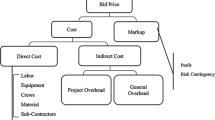Abstract
Since the mega construction project, typically defined as a contract that exceed $1 billion, requires a large scale financial investment, there exists a high possibility of having a budget constraint and limitation during the project execution stage as well as the planning stage. The previous studies were limited to analyzing the resource-constrained scheduling problems in the case of a budget constraint during the initial stage with smaller-scale projects and have never presented comprehensive approaches for rescheduling during the implementation stage and calculating its overall cost impact, especially on mega projects. As such, this study aimed to examine the methodologies and limitations of the previous studies and to analyze solutions to solve their shortcomings, thereby presenting a better methodology to practically apply to mega projects. Specifically, this study assessed the heuristic method that is the most applicable to mega projects and applied it to a real mega project, thereby suggesting a new method of construction process adjustment. The suggested method is expected to be appropriately used as a solution to similar issues with no restrictions to the size of the project.
Similar content being viewed by others
References
Ahuja, H. H., Dozzi, S. P., and Abourizk, S. M. (1994). “Project management-second edition.” John Wily & Sons, INC, pp. 127–150.
Alcaraz, J. and Maroto, C (2001). “A robust general algorithm for resource allocation in project scheduling.” Annals of Operations Research, DOI: 10.1023/A:1010949931021.
Ban, K. (2013). “Project Finance.” Korea Institute of Finance.
Bowers, J. A. (1995). “Criticality in resource constrained networks.” Journal of the Operational Research Society, Vol. 46, No. 1, pp. 80–91, DOI: 10.2307/2583838.
Cheng, R. and Gen, M. (1997). “Resource constrained project scheduling problem using genetic algorithms.” Intelligent Automation and Soft Computing, Vol. 3, No. 3, pp. 273–286, DOI: 10.1080/10798587. 1997.10750708.
Davis, E. W. and Patterson, J. H. (1975). “A comparison of heuristic and optimum solution in resource-constrained project scheduling.” Management Science, Vol. 21, No. 8, DOI: 10.1287/mnsc.21.8.944.
De La Garza, J. M., Vorster, M. C., and Parvin, C. M. (1991). “Total float traded as commodity.” Journal of Construction Engineering and Management, Vol. 117, No. 4, pp. 716–727, DOI: 10.1061/(ASCE)0733-9364(1991)117:4(716).
Hartman, S. (1997). A competitive genetic algorithms for resourceconstrained project scheduling, Christian-Albrechts-Universität zu Kiel.
Hegazy, T. (2002). Computer-Based Construction Project management, University of Waterloo Ontario, pp. 170–198.
Kim, K. and de la Garza, J. M. (2003). “Phantom Float.” Journal of Construction Engineering and Management, Vol. 129, No. 5, pp. 507–517, DOI: 10.1061/(ASCE)0733-9364(2003)129:5(507).
Kolisch, R. (1996). “Serial and Parallel resource-constrained project scheduling methods revisited: Theory and computation.” European Journal of Operational Research, Vol. 90, No. 2, pp. 320–333, DOI: 10.1016/0377-2217(95)00357-6.
Lee, Y. and Kim, W. (2013). Investigation of the State of Public Project Construction Duration Extension and Measures for Improvement (in Korean), Construction & Economy Research Institute of Korea.
Lu, M. and Li, H. (2003). “Resource-activity critical-path method for construction planning.” Journal of Construction Engineering and Management, Vol. 129, No. 4, DOI: 10.1061/(ASCE)0733-9364(2003)129:4(412).
Moder, J. J., Phillips, C. R., and Davis, E. W. (1970). Project Management with CPM, PERT and Precedence Diagramming, 3rd Edition, Van Nostrand Reinhold, New York, pp. 191–224.
PMI (2013). The Standard for Program Management, Project Management Institute, Second Edition.
Talbot, F. B. and Patterson, J. H. (1978). “An efficient integer programming algorithm with network cuts for solving resource-constrained scheduling problems.” Management Science, Vol. 24, No. 11, pp. 1163–1174, DOI: 10.1287/mnsc.24.11.1163.
Tseng, L. Y. and Chen, S. C. (2006). “A hybrid metaheuristic for the resource-constrained project scheduling problem.” European Journal of Operational Research, Vol. 175, No. 2, pp. 707–721, DOI: 10.1016/j.ejor.2005.06.014.
Wiest, J. D. (1964). Some properties of schedule for large projects with limited resources, University of California.
Wiest, J. D. (1967). “A heuristic model for scheduling large projects with limited resources.” Management Science, DOI: 10.1287/mnsc.13.6.B359.
Zack, J. G. Jr. (2000). “Pacing delays – the practical effect.” Cost Engineering, Vol. 42, No. 7, pp. 89–96.
Author information
Authors and Affiliations
Corresponding author
Rights and permissions
About this article
Cite this article
An, SM., Woo, S., Cho, CS. et al. Development of budget-constrained rescheduling method in mega construction project. KSCE J Civ Eng 21, 85–93 (2017). https://doi.org/10.1007/s12205-016-0966-7
Received:
Accepted:
Published:
Issue Date:
DOI: https://doi.org/10.1007/s12205-016-0966-7




